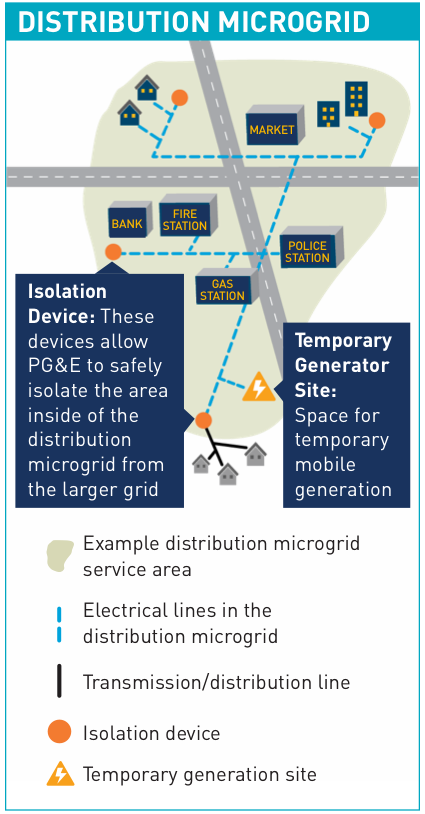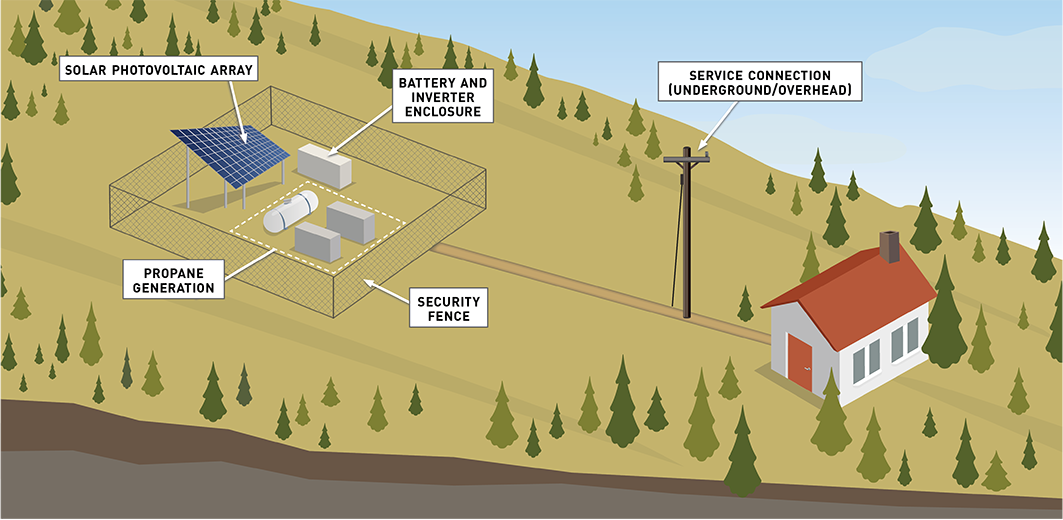- Distribution microgrids
- Remote grids
- Frequently asked questions
Public Safety Power Shutoffs (PSPS) and other outages might happen in your community. Distribution microgrids provide power when the electric system is down. They often power resources like hospitals and schools.

Remote grids
We're installing remote grids to reduce wildfire risk.
Remote grids provide power in less-populated, high fire-risk areas. They are installed on eligible private properties.
These systems offer service separately from the grid. They combine solar, batteries and generators to:
- Reduce wildfire risk by removing electric poles and overhead powerlines.
- Provide safe and reliable electric service.
- Reduce service gaps during severe weather or PSPS outages.
To learn more, call 1-877-295-4949 or email us at remotegrid@pge.com.

We send phone, text and email notifications to customers likely to be impacted by a PSPS outage. The notifications will indicate if you can be served by a microgrid. You can also find outage details for your address using our outage map.
We use distribution microgrids only when and where it is safe to do so. This includes targeted and isolated areas that are:
- Served by underground powerlines
- Outside high fire-risk areas
- Outside the PSPS weather footprint
Outages keep workers safe. Our crews need to connect and disconnect the manually operated power source to the grid. This includes the temporary generators powering distribution microgrids. This work can take up to four hours. Customers will experience brief outages during this time.
We mainly use diesel-powered generation. This does not include the Redwood Coast Airport Microgrid. This microgrid is powered by solar and battery energy storage. We aim to minimize emissions by using cleaner burning engines. We are testing more sustainable and renewable options for future use.
The Redwood Coast Airport Microgrid project is a community-driven microgrid. It is powered by third-party owned solar and battery energy storage. It is funded by the Redwood Coast Authority, Schatz Energy Research Center and PG&E's Community Microgrid Enablement Program.
They will not change. A Remote Grid won't add charges or increase energy rates. Eligible customers may continue to choose from available rate schedules. You will still receive service as a PG&E, Community Choice Aggregator or Direct Access customer.
PG&E will own and operate the Remote Grid. This will be done at no added cost to the property owner. We'll inspect and maintain the Remote Grid year-round. We'll monitor the system remotely. If an outage occurs, we'll restore service. PG&E will also conduct vegetation management to reduce wildfire risk.
Each location will be a little different. We'll work with the owner to lay out what the Remote Grid would look like. Then, we'll install the equipment in a 40-by-60-foot fenced area. This site will be within 500 feet of your property's electric panel or meter. In general, the equipment includes a solar array, containers for batteries and electrical equipment, a propane tank and a backup generator. PG&E will install a security fence around the power system.
Remote Grids produce clean, continuous and reliable energy. Remote Grid customers may experience fewer outages from severe weather. While Remote Grids aren't totally immune to interruptions, they are a very reliable power source.
PG&E will contact eligible customers about the Remote Grid. If the location meets the program's requirements, we'll review the project with the owner. At that point, we'll answer questions and address any needs the owner may have.
More information on outages and safety
Safety
At PG&E, nothing is more important than safety.
Outage preparedness and support
Stay prepared for power outages and get support.
Community Wildfire Safety Program (CWSP)
Find out how we are making our system safer and more reliable.
